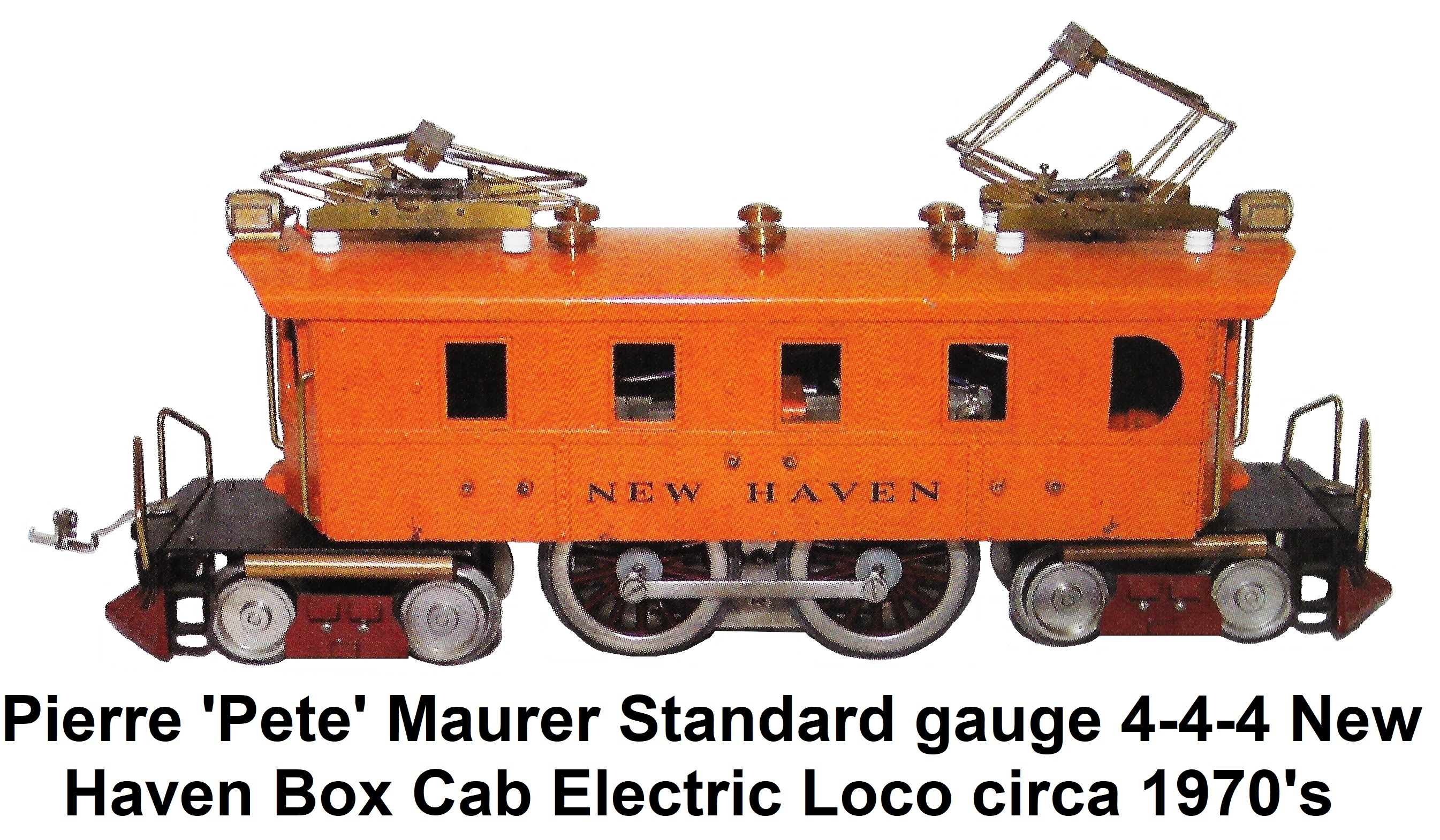 Pierre 'Pete' W. Maurer of Newark / Nutley NJ, began building 'O' scale model Pennsylvania Railroad DD1 locomotives in 1947.
He later built Milwaukee Road Bipolar EP-2 locomotives and various standard gauge electric engines. Pete was still selling
his 'O' scale Milwaukee Road Bipolar Electrics as late as the early to mid-1970's. In addition to the Pennsylvania
Railroad DD1 and Milwaukee Road Bi-Polar, Pete also modeled an L5a, Box Cab Electric's in several wheel configurations and
he modified/customized the Bob McCoy Cascade E-2 4-4-4-4 locomotive in a manner that changed its
look and profile tremendously. Under the name P.W. Maurer Importers, of Irvington, NJ, he issued catalogs and offered
live-steam locomotive models manufactured by the British Bassett-Lowke Ltd..
Pierre 'Pete' W. Maurer of Newark / Nutley NJ, began building 'O' scale model Pennsylvania Railroad DD1 locomotives in 1947.
He later built Milwaukee Road Bipolar EP-2 locomotives and various standard gauge electric engines. Pete was still selling
his 'O' scale Milwaukee Road Bipolar Electrics as late as the early to mid-1970's. In addition to the Pennsylvania
Railroad DD1 and Milwaukee Road Bi-Polar, Pete also modeled an L5a, Box Cab Electric's in several wheel configurations and
he modified/customized the Bob McCoy Cascade E-2 4-4-4-4 locomotive in a manner that changed its
look and profile tremendously. Under the name P.W. Maurer Importers, of Irvington, NJ, he issued catalogs and offered
live-steam locomotive models manufactured by the British Bassett-Lowke Ltd..
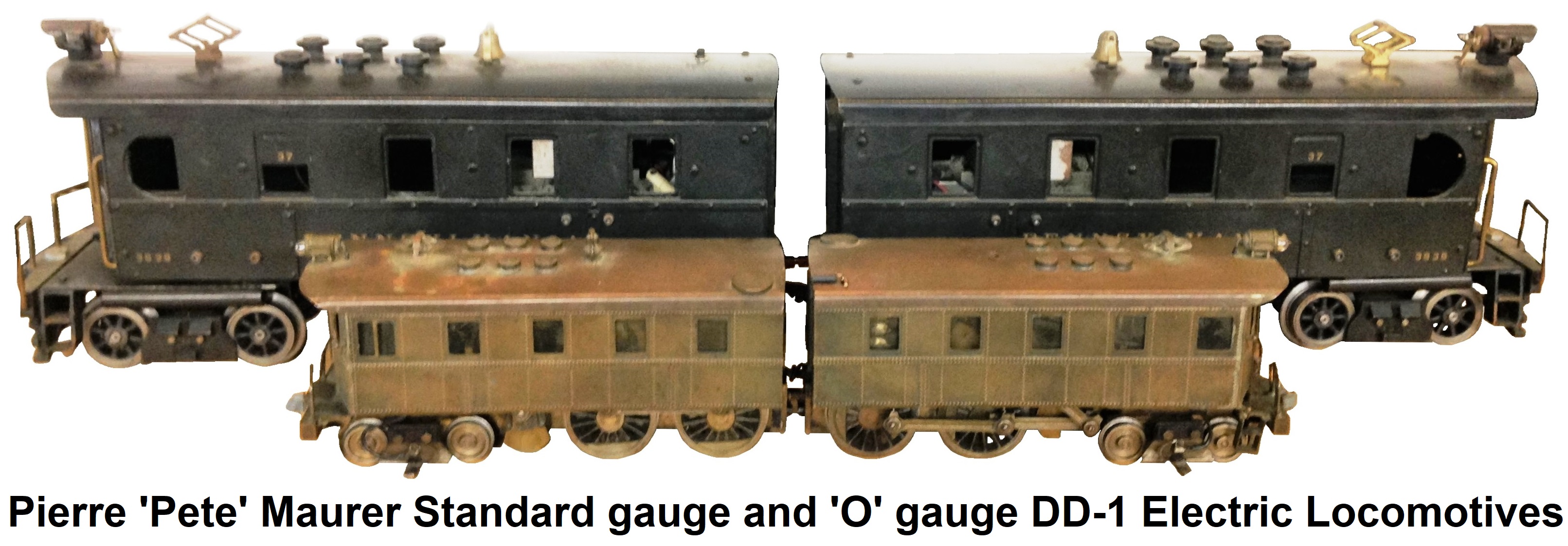
A 1947 advertisement indicated that Pete Maurer's company was located at 75 Finlay Pl., in Newark, NJ.
The Maurer 'O' 1/4" scale Pennsylvania Railroad DD1 Electric locomotive was built entirely of steel and brass, bronze
and iron castings, except for die-cast working couplers. The drive was facilitated from cranks attached to the electric motors
located inside the engine cab through connecting rods, just like the full-sized prototype it was modeled after. The
DD1 prototype was a class of box cab electric locomotives built by the Pennsylvania Railroad in 1910. The locomotives were
developed as part of the railroad's New York Tunnel Extension, which built the original Pennsylvania Station in New York City
and linked it to New Jersey via the North River Tunnels. The Pennsylvania built a total of 66 DD1 locomotives in its Altoona
Works and they operated in semi-permanently coupled pairs. Westinghouse supplied the electrical equipment. The Maurer DD1
'O' scale model featured 2 K&D motors, one in each of the two units. All the drivers and pilot wheels were sprung. The
crankshafts and drivers ran in 16 roller bearings. The locos featured operating headlights. The chassis were painted dull
black and the cab was left in natural bronze, while the roof was polished brass. It came in a 3-rail version for a $400
price tag. It was also available for outside 3rd rail operation. Maurer later built a standard gauge Pennsy DD1 as well
that operated on 3-rail track.
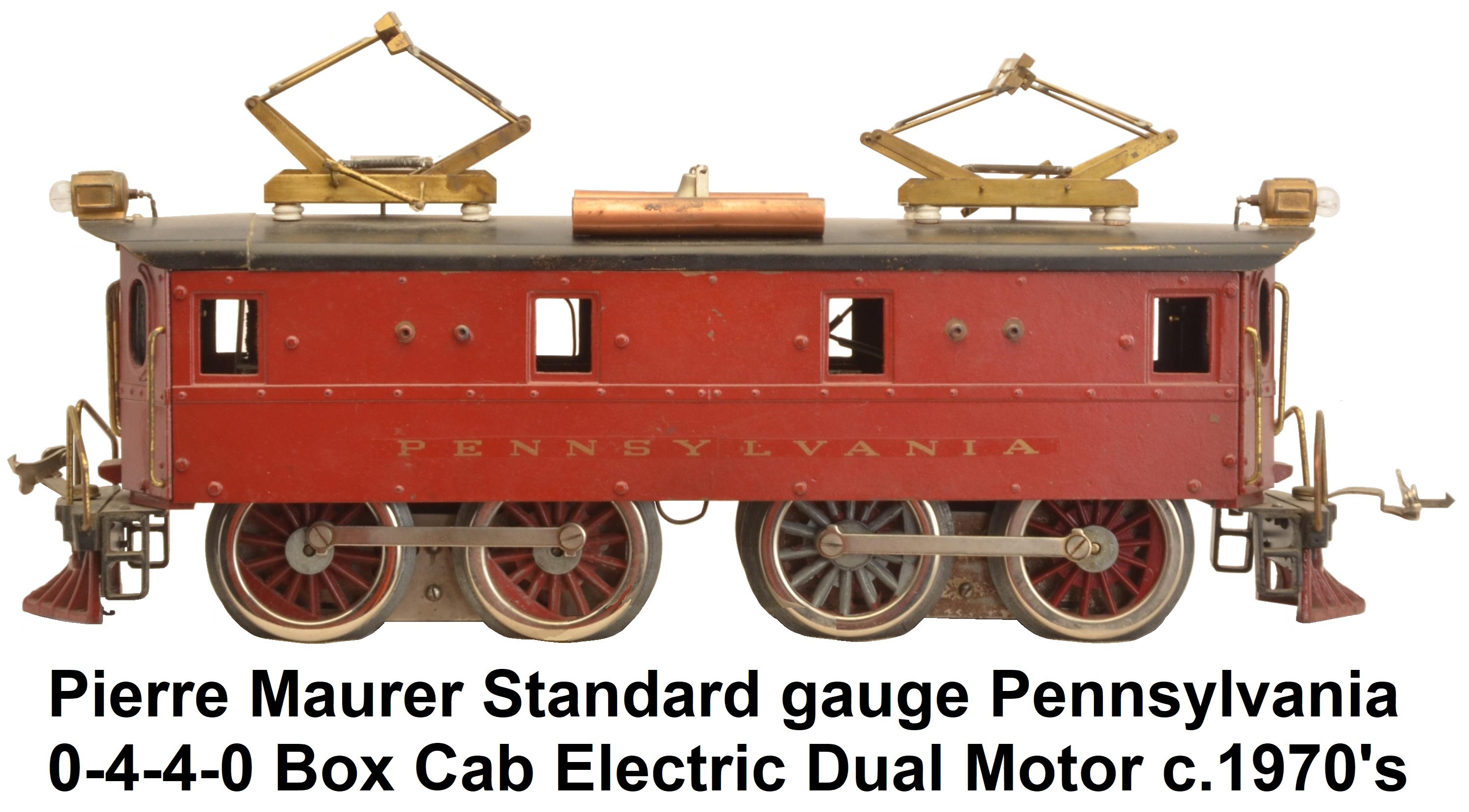
Pete Maurer was a big train fan and collector who was also very talented at building model trains. In addition to the 'O'
scale and the Standard gauge DD1 locomotives, in the 1960's and 70's Pete Maurer also built various other Standard and 'O'
gauge pieces. Since he liked electric locomotive prototypes from the early 20th century, he decided to build a model
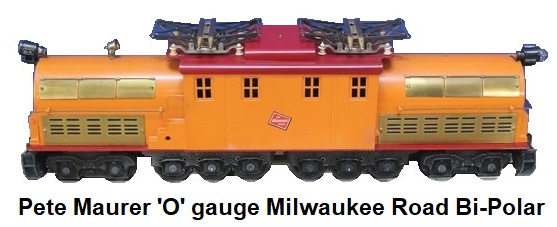 of the Milwaukee Road Bipolar EP-2 Electric Locomotive in bright orange sheet steel and brass in 'O' gauge. This became one
of his most sought after models based on a real prototype. The Milwaukee Road's class EP-2 comprised five electric
locomotives built by General Electric in 1919. They were often known as Bipolars, which referred to the bipolar electric
motors they used. Among the most distinctive and powerful electric locomotives of their time, they epitomized the
modernization of the Milwaukee Road railway. These locomotives came to symbolize the railroad during their nearly 40
years of use. Maurer's 'O' gauge Bipolar model utilized a GG-1 chassis, motor and 4-6-6-4 running gear.
of the Milwaukee Road Bipolar EP-2 Electric Locomotive in bright orange sheet steel and brass in 'O' gauge. This became one
of his most sought after models based on a real prototype. The Milwaukee Road's class EP-2 comprised five electric
locomotives built by General Electric in 1919. They were often known as Bipolars, which referred to the bipolar electric
motors they used. Among the most distinctive and powerful electric locomotives of their time, they epitomized the
modernization of the Milwaukee Road railway. These locomotives came to symbolize the railroad during their nearly 40
years of use. Maurer's 'O' gauge Bipolar model utilized a GG-1 chassis, motor and 4-6-6-4 running gear.

Maurer also developed an L5 Electric locomotive in Standard gauge, which Bob Hendrich of
Glendora, California (Gold Standard Engineering) later rebuilt. The Pennsylvania Railroad's class L5
were the railroad's second generation of production electric locomotives after the DD1, and the last to use a jackshaft and
side rods to drive the wheels. The L5 was a single-unit locomotive instead of the twin-unit DD1. The wheel arrangement in
Whyte notation was 2-4-4-2, or 1-B-B-1 in the AAR scheme. Twenty five were built. The first unit of the class was equipped
for AC operation with an overhead pantograph (later two), while the other 24 were third rail DC units to work on the existing
PRR third rail electrification in the New York area. The L5 was not as successful as the DD1 as the side rod electric
locomotive concept proved to be unsuited to the demands of long distance electrification. The Maurer L5 was powered by 2 K&D
or KMT spur gear driven Bild-A-Loco type motors, with cast iron wheels. The L5 was worm driven through
a jack shaft to the driving wheels, just like the prototype. The body was made of cast bronze and steel.
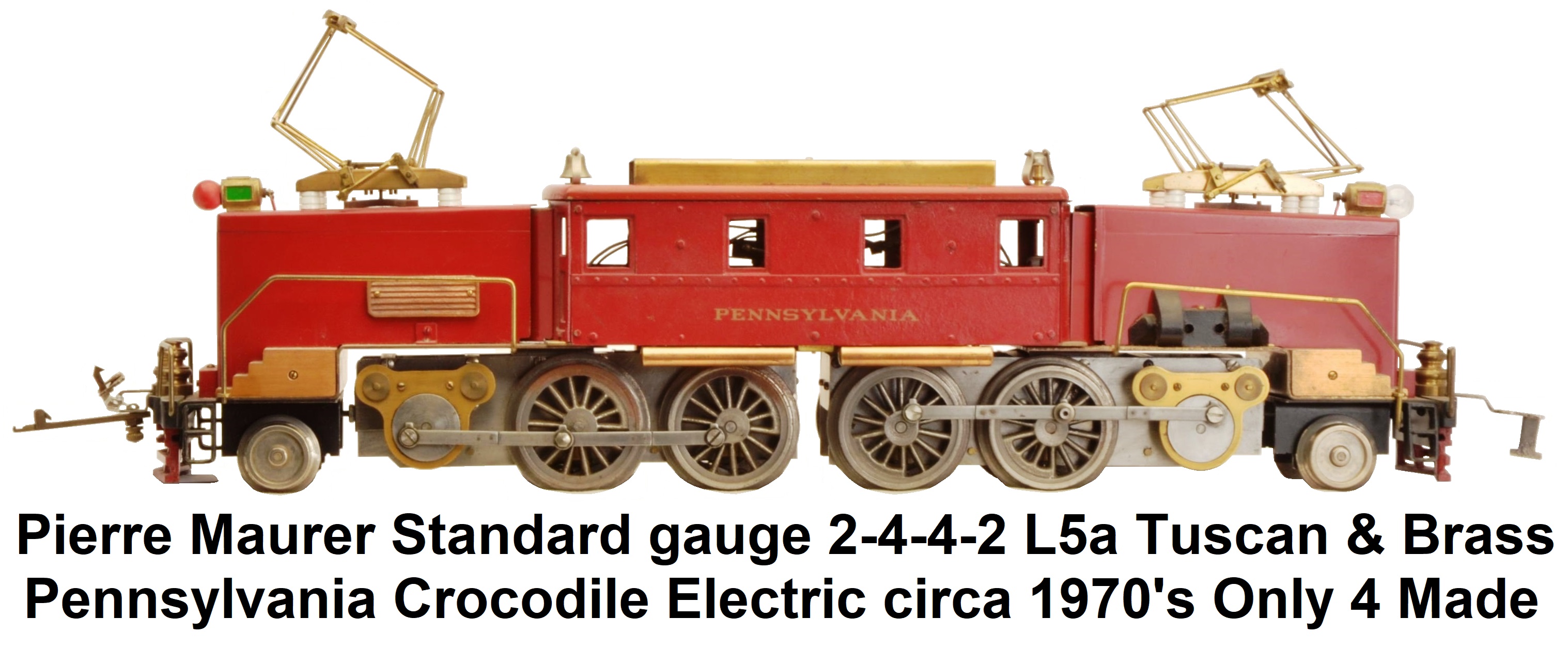
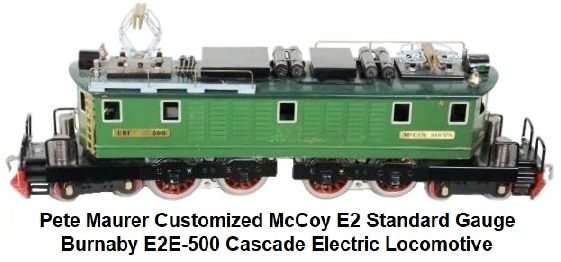 Maurer redesigned the Standard gauge McCoy Cascade E-2
4-4-4-4 electric locomotive and took it to a higher level by adding ladders, catwalks, scale pantographs and scale roof
details, designating it an E3. He also enabled the ability to actually power the engine via its pantographs, and customized
the paint schemes. Pete Maurer also adorned the loco with brass plates, similar to the early pre-war Standard gauge tinplate
trains made by manufacturers like Lionel, American Flyer, and
Ives Toys. McCoy's E-2 was not really a prototypical model of anything. It was most likely patterned
after the Great Northern Railway's class Y-1 Electric locomotives from the 1920's and 30's with AAR 1-C+C-1 wheel
arrangements. Eight of these locomotives were built by Alco and General Electric and were used on the 73-mile (117 km)
electrified portion of the GN railroad, from Wenatchee, Washington to Skykomish, Washington, including the Cascade Tunnel.
In the 1950's the Pennsylvania Railroad acquired these locomotives and reclassified them as the FF2.
Maurer redesigned the Standard gauge McCoy Cascade E-2
4-4-4-4 electric locomotive and took it to a higher level by adding ladders, catwalks, scale pantographs and scale roof
details, designating it an E3. He also enabled the ability to actually power the engine via its pantographs, and customized
the paint schemes. Pete Maurer also adorned the loco with brass plates, similar to the early pre-war Standard gauge tinplate
trains made by manufacturers like Lionel, American Flyer, and
Ives Toys. McCoy's E-2 was not really a prototypical model of anything. It was most likely patterned
after the Great Northern Railway's class Y-1 Electric locomotives from the 1920's and 30's with AAR 1-C+C-1 wheel
arrangements. Eight of these locomotives were built by Alco and General Electric and were used on the 73-mile (117 km)
electrified portion of the GN railroad, from Wenatchee, Washington to Skykomish, Washington, including the Cascade Tunnel.
In the 1950's the Pennsylvania Railroad acquired these locomotives and reclassified them as the FF2.
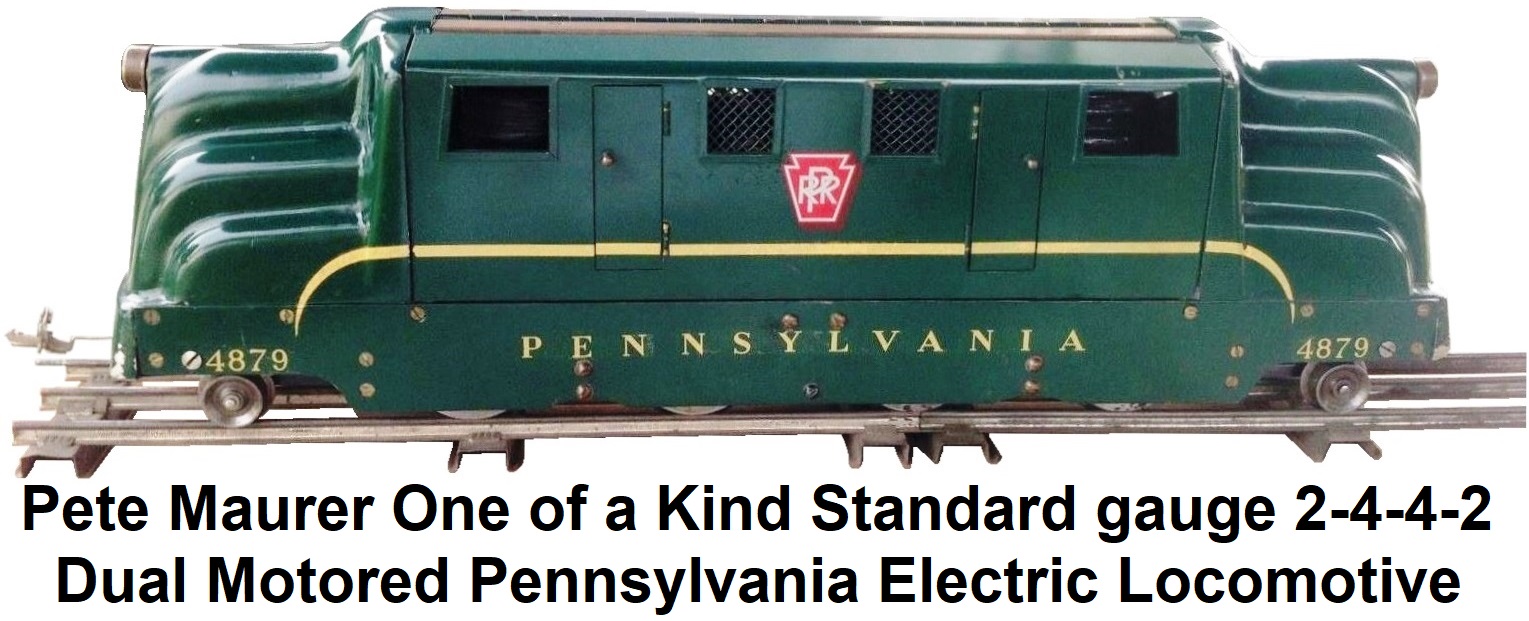 Pierre Maurer was quite a master craftsman. He was an engineering genius as well as a way-above average
machinist and technician. One of his principal missions in life was helping and bringing joy to his fellow hobbyists.
Pete, as his friends called him, devoted all his time to designing and building Standard gauge electric prototype locomotives
during his retirement years. He was a veritable genius at this and his designs of the Pennsy DD-1, L-5 Box Cab, Milwaukee
Road Bipolar Box cab, and the modifications he introduced to the McCoy Cascade E-2 to which he
affixed more detail, have earned him a page in the world of model railroad development history. His products always operated
beautifully. Sadly he passed away in 1978, but the legacy of his creations lives on. Because all his trains were hand built,
there were very limited quantities produced, and therefore these treasures are very rare and highly coveted by collectors
today.
Pierre Maurer was quite a master craftsman. He was an engineering genius as well as a way-above average
machinist and technician. One of his principal missions in life was helping and bringing joy to his fellow hobbyists.
Pete, as his friends called him, devoted all his time to designing and building Standard gauge electric prototype locomotives
during his retirement years. He was a veritable genius at this and his designs of the Pennsy DD-1, L-5 Box Cab, Milwaukee
Road Bipolar Box cab, and the modifications he introduced to the McCoy Cascade E-2 to which he
affixed more detail, have earned him a page in the world of model railroad development history. His products always operated
beautifully. Sadly he passed away in 1978, but the legacy of his creations lives on. Because all his trains were hand built,
there were very limited quantities produced, and therefore these treasures are very rare and highly coveted by collectors
today.
At the September 2022 Stout Auction of the Arno Barrs collection of modern era Standard gauge trains,
several original models built by Pete Maurer sold for incedible prices. An L5a Tuscan and brass Pennsylvania 2-4-4-2
crocodile electric loco, circa 1970's, of which only four were made (pictured above), while estimated to sell for $2,500
max, reached a final gavel price of $7,400.00. At the same auction, a Pierre Maurer Standard gauge maroon 0-4-4-0 PRR Box Cab
Electric Loco with black roof, sold for $1,100 and a Pierre Maurer Standard gauge orange 4-4-4 New Haven Box Cab Electric Loco
went for $750.
Before retirement, Pete Maurer had a career at RCA, and built radar systems during
World War II. According to one of his nephews, Pete did not have a college degree, but he was very talented in the technical
fields, and was awarded several patents by the US Patent office.
